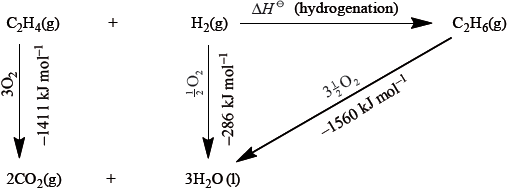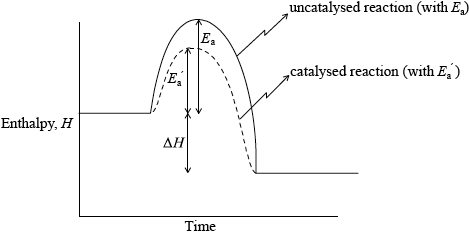Question
An equation for the combustion of propane is given below.
C3H8 (g) + 5O2 (g) → 3CO2 (g) + 4H2O (g)
(a) Determine the standard enthalpy change, ΔHΘ, for this reaction, using section 11 of the data booklet. [3]
(b) Calculate the standard enthalpy change, ΔHΘ, for this reaction using section 12 of the data booklet. [2]
Answer/Explanation
Ans:
a
Bonds broken: 8(C–H) + 2(C–C) + 5(O=O) / 8 × 414 «kJ mol−1» + 2 × 346 «kJ mol−1» + 5 × 498 «kJ mol−1» / 6494 «kJ»
Bonds formed: 6(C=O) + 8(O–H) / 6 × 804 «kJ mol−1» + 8 × 463 «kJ mol−1» / 8528 «kJ»
«Enthalpy change = bonds broken − bonds formed = 6494 kJ − 8528 kJ =» −2034 «kJ»
Award [3] for correct final answer.
b
4(−241.8 «kJ») AND 3(−393.5 «kJ») AND «1»(−105 «kJ»)
«∆HƟ = 4(−241.8 «kJ») + 3(−393.5 «kJ») – «1»(−105 «kJ») =» − 2043 «kJ»
Question
(a) Determine the change in enthalpy, ΔH, for the combustion of but-2-ene, using data booklet. [3]
CH3CH=CHCH3 (g) + 6O2 (g) → 4CO2 (g) + 4H2O (g)
Answer/Explanation
Ans:
a
Bonds broken: 2(C–C) + 1(C=C) + 8(C–H) + 6O=O / 2(346) + 1(614) + 8(414) + 6(498) / 7606 «kJ»
Bonds formed: 8(C=O) + 8(O–H) / 8(804) + 8(463) / 10 136 «kJ»
Enthalpy change:
«Bonds broken – Bonds formed = 7606 kJ – 10 136 kJ =» –2530 «kJ»
Award [3] for correct final answer.
Award [2 max] for «+» 2530 «kJ».
Question
Two students were asked to use information from the Data Booklet to calculate a value for the enthalpy of hydrogenation of ethene to form ethane.
\[{{\text{C}}_2}{{\text{H}}_4}{\text{(g)}} + {{\text{H}}_2}{\text{(g)}} \to {{\text{C}}_2}{{\text{H}}_6}{\text{(g)}}\]
John used the average bond enthalpies from Table 10. Marit used the values of enthalpies of combustion from Table 12.
John then decided to determine the enthalpy of hydrogenation of cyclohexene to produce cyclohexane.
\[{{\text{C}}_{\text{6}}}{{\text{H}}_{{\text{10}}}}{\text{(l)}} + {{\text{H}}_{\text{2}}}{\text{(g)}} \to {{\text{C}}_{\text{6}}}{{\text{H}}_{{\text{12}}}}{\text{(l)}}\]
Calculate the value for the enthalpy of hydrogenation of ethene obtained using the average bond enthalpies given in Table 10.
Marit arranged the values she found in Table 12 into an energy cycle.

Calculate the value for the enthalpy of hydrogenation of ethene from the energy cycle.
Suggest one reason why John’s answer is slightly less accurate than Marit’s answer.
Use the average bond enthalpies to deduce a value for the enthalpy of hydrogenation of cyclohexene.
The percentage difference between these two methods (average bond enthalpies and enthalpies of combustion) is greater for cyclohexene than it was for ethene. John’s hypothesis was that it would be the same. Determine why the use of average bond enthalpies is less accurate for the cyclohexene equation shown above, than it was for ethene. Deduce what extra information is needed to provide a more accurate answer.
Answer/Explanation
Markscheme
energy required = C=C + H–H/612 + 436 and
energy released = C–C + 2(C–H)/347 + 2(413) /
energy required = C=C + H–H + 4(C–H)/612 + 436 + 4(413) and
energy released = C–C + 6(C–H)/347 + 6(413);
\(\Delta H = – 1411 + ( – 286) – ( – 1560) = – 137{\text{ kJ}}\,{\text{mo}}{{\text{l}}^{ – 1}}\);
the actual values for the specific bonds may be different to the average values / the combustion values referred to the specific compounds / OWTTE;
\( – {\text{125 kJ}}\,{\text{mo}}{{\text{l}}^{ – 1}}\);
average bond enthalpies do not apply to the liquid state / OWTTE;
the enthalpy of vaporization/condensation of cyclohexene and cyclohexane / OWTTE;
Examiners report
Candidates struggled with Part (a). The most common errors were those of calculation, incorrect identification of the bonds involved and a final answer with the opposite sign and missing units.
In (b) many candidates found it difficult to use Hess’ Law with the cycle presented in this form, a good proportion not recognising that this was, indeed, a Hess’ Law calculation.
In Part (c) many of the candidates simply repeated the question, giving no reason or explanation for the likely difference in accuracy.
Many candidates repeated the calculation from (a) in (d)(i) instead of realising that the question asked for a deduction rather than another calculation. Credit was given if the same (even if incorrect) answer was obtained as in part (a).
In (d)(ii) very few candidates seemed to notice that this process involved substances in the liquid state hence the need for enthalpies of vaporization/condensation. It was commonly thought that the position of the double bond in the cyclohexene ring would make a significant difference.
Question
Define the term activation energy, \({E_{\text{a}}}\).
State two conditions necessary for a reaction to take place between two reactant particles.
Sketch an enthalpy level diagram to describe the effect of a catalyst on an exothermic reaction.
Answer/Explanation
Markscheme
(minimum) energy needed for a reaction to occur / (minimum) energy difference between reactants and transition state;
particles must collide;
appropriate collision geometry/orientation;
\(E \geqslant {E_{\text{a}}}\);
Diagram showing:
correct labelling of axes (enthalpy/H/(potential) energy for y-axis and time/progress/course of reaction/reaction coordinate for x-axis) and H (products) line shown below H (reactants) line;
correct labelling of the two curves, catalysed and uncatalysed;
correct position of \({E_{\text{a}}}\) shown with lines for a catalysed and uncatalysed reaction;
the correct label \(\Delta H\) /change in enthalpy;
Do not penalize if reactants and products are not labelled.

If an endothermic reaction is shown, award [2 max] if all other parts are shown correctly.
Examiners report
Most candidates gave the correct definition of activation energy in (a).
The two conditions needed for a reaction to take place were given by the majority of candidates.
In (c) some of the enthalpy level diagrams had many labels missing. Axes weren‟t always labelled, one of them was wrongly labelled as delta H, and the curves of Ea with and without catalyst were not properly indicated. A few answers showed an endothermic reaction instead.
